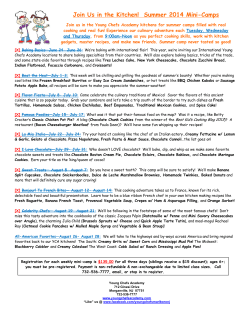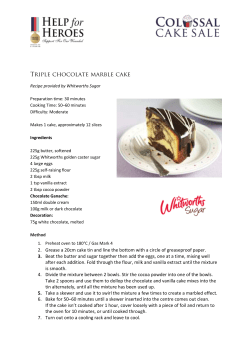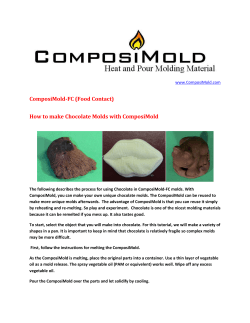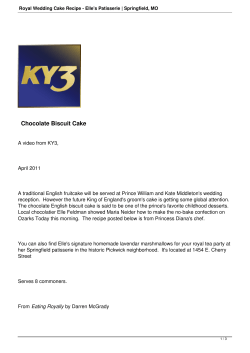
IS-IT Learning? Implementing collaborative interdisciplinary scenario inquiry tasks in large first-year
IS-IT Learning? Implementing collaborative interdisciplinary scenario inquiry tasks in large first-year science classes Gwen Lawrie Project Team: Kelly Matthews (TEDI, UQ), Lawrence Gahan (Chemistry, UQ), Peter Adams (Maths/FoS, UQ), Lydia Kavanagh (Engineering, UQ), Philip Long (CEIT, UQ), Mathew Taylor (CBIT, UQ) Gabriela Weaver (Purdue University) Context: Large 1st Yr STEM Classes Challenges: • Very large, diverse cohorts (career aspiration, academic ability, prior experiences) • Low engagement Chemistry 2010 (S2) B Health Sci 3% B Biomed Sci 8% BSc/BEd 25 other programs 7% 1% B App B Sci Biotec 5% h 3% Bcomm/BSc BSc 29% 1% (relevance, motivation) • Transferable skills (collaboration, communication, selfdirected learning) BSc/BA 3% B Eng 7% B Pharm 17% MBBS/BSc 11% B Dent Sci 4% B Env Sci 1% B Mar St 0% Example of Inquiry-Guided Learning (IGL)? ‘acquisition of new knowledge, abilities, and attitudes through students’ increasingly independent investigation of questions, problems, and issues, for which there often is no single answer’ (Virginia Lee, 2004) Inquiry Guided Learning Active Learning Inductive T&L methods URE PBL Brew, Healey, Lee, Levy, Spronken-Smith Interdisciplinary Scenario-Inquiry Tasks Successful completion of an IS-IT will require students to utilise the following skills: 1. 2. Interdisciplinary thinking – Analysis of real world scenarios requiring interdisciplinary approaches Scientific reasoning – Interpret and utilise evidence through a logical decision making process to make sound judgements 3. Scientific communication - Fluent communication in a disciplinary language 4. Quantitative reasoning - Integration of data with logical arguments including graphical displays 5. Information literacy - Information retrieval and validation 6. Visualisation - Construction of conceptual models 7. Team work – Effectively work within a team 8. Global citizenship – Develop social and ethical responsibility Cooperative learning The 5 guiding principles: Positive interdependence. Individual accountability. Social skills. Group processing. Communication (F2F or virtually). Slavin, Johnson & Johnson, Smith, Prince & Felder Evolution of a Group Task Instructional Design of IS-IT Research Task • Choice of scenario • Self-selection of groups (4) • Interdependence achieved through individual responsibility (IQ) • Collective product: response to a Meta-Q • Peer evaluation of group members (internal) • Peer evaluation of other reports in same scenario (external) 27 Scenarios available Survival in the Death Zone – Ocean Floor The limits of Global Food Production Fermentation Fever Living in the Shadow of the Mushroom Cloud Chocoholics Anonymous Waste Not Want Not! Bottoms Up! Cancer Treatment A Sugar Rush >1350 students …. Has to be computer assisted! Example Scenario IQ1 IQ2 NATURALLY WONDERFUL THE GOOD, THE BAD & THE UGLY! From bean to bar, the process of chocolate making is part art and part science. 2012 IS-IT Meta-Q IQ3 DESIGN ME A CENTRE Formulations with chocolate rely heavily on chemistry and, in some cases, biotechnology. Healthy chocolate! Is the biggest barrier to the success of this ultimate product related to production or to consumer perception? The balance between sugar and fat content in chocolate can be extremely wide ranging depending on the intended taste or quality. IQ4 LIFTING SPIRITS Chocolate can have an effect on emotion & alertness, but it contains compounds that can affect physiology and health in a number of other ways Task Flowchart Login View Scenarios (27) Register for Scenario Join Group Submit Research Report Work Collaboratively on Meta-Q Internal Peer Assessment External PeerReview = iCAS deadline Nominate for Individual Quest ‘Team Work’ Module Information Retrieval IQ Submission Academic Mark + Feedback & Moderation iCAS Technology http://icas.science.uq.edu.au/login.aspx?ReturnUrl=%2f How do we know if IS-ITs were effective? Learning Process Learning Environment Group processing – balance between social and cognitive factors Task management & Supporting resources, Learning Outcomes Evidence of learning gains: perceptions & products IS-IT Prof Carmel McNaught (CUHK), Project External Evaluator Collaborative processes ‘How did your group communicate?’ 115 groups did not use iCAS online collaborative space Analysis of collective reports Simply plugging IQs together State Recognise Recall Tell Enumerate Describe List Clarify Do algorithms Compare/ contrast Explain causes Analyse Relate Apply Predict Theorise Generalise Hypothesise Reflect Create Design Misses point Missing the point Single point Multiple unrelated points Quantitative phase Logically related answer Unanticipated extension Qualitative phase Collective products analysed using SOLO taxonomy (Biggs 2003). Higher level structural observation of learning outcomes associated with synergism in collaboration and integration of IQs. McNaught, C., Cheng, K. F., & Lam, P. (2006) In N. Lambropoulos & P. Zaphiris (Eds.), Usercentered design of online learning communities (pp. 161–184). Hershey, PA: ISP. Evaluation of Student Reports Peer Assessment Internal: Students reflect on individual contributions & strengths Insight into ‘interdependency’ & ‘collaborative synergy’ in groups External: Students reflect on, and critically appraising 4 group reports in the same scenario. I think from a learning perspective the external marking was great. To see when you haven’t done so good and when people have done better than you in some places and you can improve. (2010 semester 1 Focus Group) Acknowledgements iCAS Enrique Marastoni & Mike Rickerby(CBIT) Rodney Cusack (Project Manager) Chantal Bailey (iCAS Facilitator & Evaluation) IS-IT Learning? Project Team Scenario Writers Prof. Carmel McNaught (CUHK), External Evaluator ALTC Competitive Grant: CG9-1112
© Copyright 2025





















